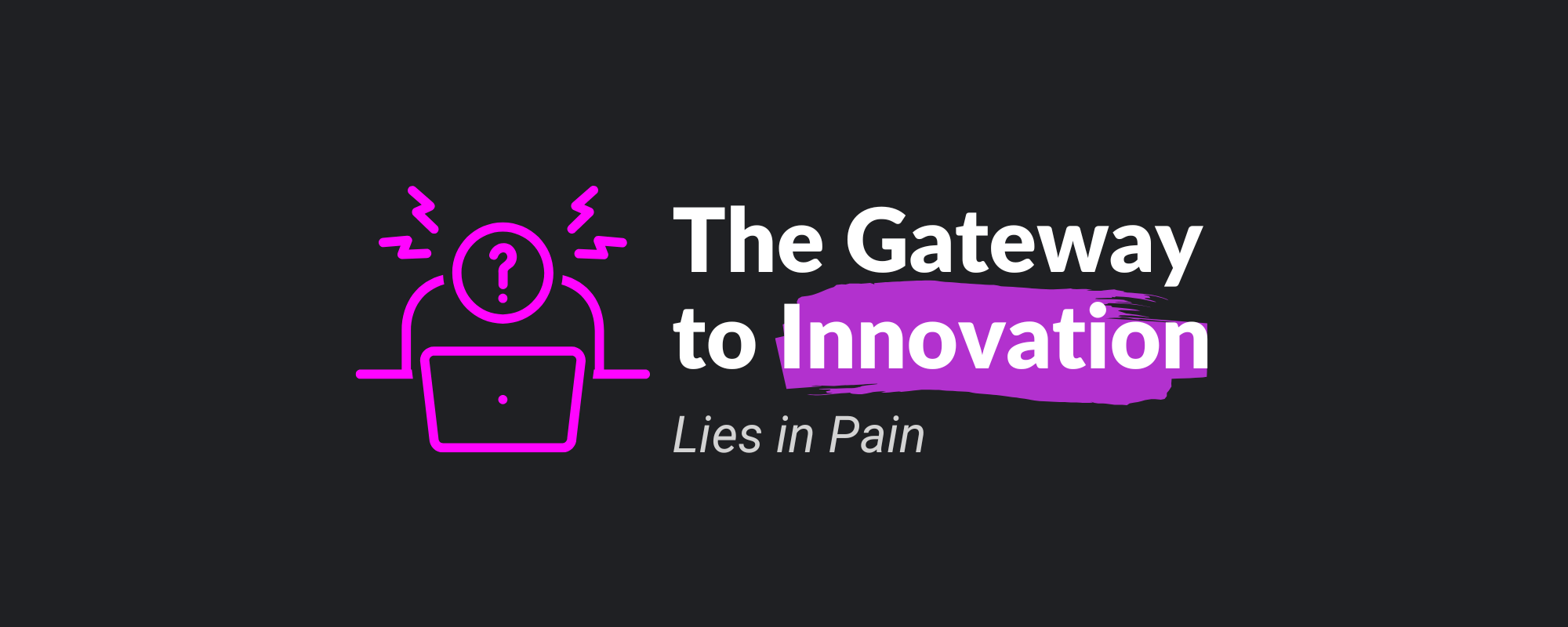The Gateway to Innovation Lies in Pain: Turn Complaints into Digital Breakthroughs

There's a secret ingredient to the best innovation stories. Spoiler alert: it's not a huge budget, a sudden spark of genius, or some magical tech wizardry. It’s much simpler than that. It’s discomfort. Frustration. Aggravation. In short, it's pain. The kind that doesn’t let you rest. The kind that pulls you out of bed at midnight to type an angry customer service message. The kind that brands often dismiss as noise, but shouldn’t. Because the truth is, the discomfort of your customers is the gateway to your next big breakthrough.
Think of the last time you went on a long walk and a tiny pebble found its way into your shoe. Small, insignificant—but absolutely maddening. That pebble shapes the entire walk. If you keep walking, it blisters. If you stop and fix it, you can stroll comfortably again. This is what a customer pain point feels like to your audience. A tiny problem that impacts the broader journey, potentially making or breaking their experience with your brand.
A brand's innovation is about finding those tiny pebbles that trouble your customers and removing them. Recognize the power in their discomfort, listen deeply, and you'll find that every complaint can be your roadmap to progress.
Customer Pain Points: Gold Mines, Not Grievances
Organizations often get caught up trying to dazzle customers. They want to create delight. They want fireworks, surprise gifts, unboxing videos that go viral. It’s all well and good—until your customer finds that pebble. And what do they really want in that moment? Not a grand gesture, but a solution. They want their shoes to fit comfortably. They don’t need a free pair of socks, they need you to solve the problem that’s holding them back from enjoying the journey.
This is where true innovation lies. Not in adding more fluff, but in solving problems that nobody else is willing to solve. Look at your customer complaints, really look at them. It’s often easy to dismiss them as "negative feedback" or something to avoid. But every complaint is an opportunity—an opportunity for genuine connection, for problem-solving, and for innovation.
As seasoned strategist says, "Brands that know how to listen always have the competitive advantage." Customers aren’t just paying for your product or service; they're paying for the experience. They’re investing in how well your brand makes their lives easier, smoother, or just better. The magic lies in taking the frustration and using it as fuel for transformation.
Listening Is Free Consulting
So how do you uncover these opportunities? How do you take that raw frustration and turn it into something impactful? The first step is to listen. Not just hear, but listen. Actively, consistently, and with intent.
There are so many ways to do this: customer surveys, social media monitoring, online reviews. The usual suspects. But it’s not just about collecting data; it’s about seeing the trends that emerge, the common themes. It’s about treating public whining as free consulting. Customers are handing you what you need on a platter—often, the very solutions they wish they had. They’re practically offering to be your R&D department. You just have to pay attention.
Take, for example, Khoros’s stat that “91% of customers say they’re more likely to make another purchase after a great customer service experience” [1]. It tells us that addressing these pain points pays off in spades, literally. Customers want to come back. They just need a reason to.
Identifying the Pebbles in Your Customer's Shoe
Once you’ve gathered the complaints, the next challenge is to sift through and identify which ones really matter. Let’s be honest—not all pain points need revolutionary action. Some may just need a bit of empathy. But there are those key issues that, if addressed, could fundamentally change your customer’s experience.
Enter the RICE Framework (Reach, Impact, Confidence, Effort). This framework helps you prioritize by asking:
- Reach: How many customers are impacted by this pain point?
- Impact: How significant is the effect if it’s solved?
- Confidence: How confident are we that we can solve it effectively?
- Effort: What level of resources will be required?
This isn’t about just throwing resources at problems. It’s about being smart—picking the battles that make the biggest difference. Think of your customer pain points like dominoes. Sometimes you only need to solve one key problem to make other smaller ones fall into place. Sometimes solving the authentication issue for your app solves five other issues connected to user experience, loyalty, and even customer spending.
Salesforce Research tells us “84% of consumers say being treated like a person, not a number, is key to winning their business” [2]. Your customers don’t want you to slap a band-aid on their pain; they want you to understand it, and solve it in a way that speaks to them as individuals.
Turning Pain Points Into Digital Solutions
One of the best examples of turning pain into innovation comes from a bank in the UAE. After countless customer complaints about a clunky, cumbersome mobile payment authentication process, they realized something had to change. Customers found it frustrating, slow, and counterproductive—every transaction felt like getting that pebble back in their shoe.
The solution wasn’t about creating new features but refining what already existed. Simplifying authentication, making it a seamless one-touch approval, transformed not just the mobile app, but the customers' overall relationship with the brand. The complaints stopped; transactions soared. All because they listened.
This isn’t about adding bells and whistles to impress your audience; it's about truly fixing what's broken. It's the pebble removal approach to innovation. And let’s not forget, Convin shows that “74% of companies say good customer service directly impacts their bottom line” [3]. It’s not just about customer satisfaction; it’s about revenue.
Gauging the Impact of Your Solutions
Great, you’ve solved a customer problem—now what? Now you measure; metrics matter! Customer innovation doesn’t end with problem-solving; it continues by ensuring the solutions actually make a difference.
Here, tools like Customer Satisfaction Score (CSAT) and Net Promoter Score (NPS) become crucial. CSAT measures how satisfied customers are with a specific interaction or overall service, helping identify areas needing immediate improvement. NPS gauges customer loyalty by asking how likely they are to recommend your brand, which provides a broader picture of long-term sentiment and loyalty. These aren't just fancy metrics; they tell you if your solution hit the mark. They tell you if customers are as happy as you hoped they’d be. And they also reveal what’s next—because feedback is an evolving conversation, not a one-time Q&A.
Remember this: If nobody is complaining anymore, you might think you’ve nailed it. But keep checking your metrics. People could also have just given up on you. True silence isn't always a good sign. Follow through, keep adjusting, keep listening.
Innovation Through Understanding, Not Adding More Noise
Companies have this incessant itch to wow customers, to be groundbreaking. We spend our time figuring out how to add more. More features, more complexity, more surprises. But what customers actually crave, most times, is just for things to work. To make sense. To feel understood.
It's the simplest form of respect—fixing what’s broken before asking for applause. When you innovate by understanding, you unlock a different level of customer loyalty. You create products and services that aren't just designed to impress but are designed to truly work for the people using them.
Look at it like this: when you solve a genuine pain point, your customer’s relationship with your brand moves from transactional to emotional. They start to see you as the brand that listened. The brand that cared enough to fix what was wrong. And that kind of connection? It’s priceless.
Real Change Comes From Real Pain
So, let’s stop avoiding discomfort. Let’s see complaints for what they truly are: invitations to innovate. Customers rarely complain because they hate you; they complain because they want to love you, but they need you to make it possible. Let their pain guide you to your next breakthrough. Let their discomfort inspire a solution that not only solves their problem but makes your brand unforgettable.
Remember, the beauty isn’t just in delivering what’s new—it’s in fixing what’s broken, especially when that fix drives growth and builds a bond that lasts. Go find that pebble. Remove it. And make the walk smooth again.
[1] “91% of customers say they’re more likely to make another purchase after a great customer service experience.” – Khoros.
[2] “84% of consumers say being treated like a person, not a number, is key to winning their business.” – Salesforce.
[3] “74% of companies say good customer service directly impacts their bottom line.” – Convin.



Discussion